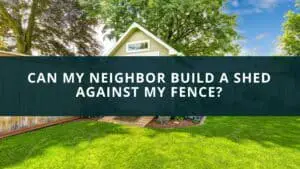Roof and ceiling don’t mean the same thing, but many people use the two words interchangeably. So, what is the difference between a roof and a ceiling?
The difference between the ceiling and roof lies mostly in their function; the roof is for the protection of the house from outdoor elements, while the ceiling serves mostly aesthetic purposes as the fifth wall. There are several types of roofs and ceilings, and materials for making both also vary.
Due to their functions, there aren’t usually any special rules that the builder must comply with regarding ceilings. As long as the material isn’t harmful, they’re good to go. Here, we discuss the difference between a roof and ceiling and the various types of both.
Quick navigation
What is a Roof
A roof is the uppermost exterior part of a building. It protects the interior of the building from weather elements, ensuring it’s safe from heat, rain, and cold. The roof serves a functional purpose, and there are generally building codes to comply with when building roofs so that they can effectively serve the purpose of protection. When choosing roofing materials and roof designs, there are things one has to consider. These include:
- The kind of roofing materials and type common to the neighborhood might be necessary not for blending in but because it’s what works best in the area.
- The building codes and homeowners’ association restrictions are also important to consider as they can limit your choice.
Roofing materials include various natural materials and chemicals capable of withstanding the harsh weather elements such as asphalt, tar, crushed stones, neoprene, EPDM, PVC, Polymer modified bitumen, chlorinated polyethylene, metal, wood, clay, slate, rubber, concrete, and ecofriendly materials such as plants and moss. At times, there’s a combination of multiple materials to create a strong, durable roof that lasts for between 20 and 30 years.
Types of Roofs
There are several types of roofs for homes, and the common ones will usually depend on the location, among several other factors. The common ones are:
1. Gable Roof
This is the most common type of roof and what you’ll find in most houses. It’s a triangular roof where the base rests on the sides of the house, and each side rises in slope to meet the ridge. The steepness of the slope differs based on the design. Gable is quite popular and works well with most homes. It’s also practical in most areas because the slope ensures that snow and rain don’t settle on the roof, which could cause damage.
2. Clipped Gable
This roof type is more complex. It has the basic shape of a roof with the slopes on either side meeting at the ridge, but it also has an element of hip roofs with a bent in top peaks. Thus, there are small hips at the end of the ridge. Also called the bullnose, this roof design is mostly aesthetic, but it also makes it easy to show off the shingles in the house.
3. Dutch Gable Roof
It’s also a combination of a gable and hip roofs. In this design, there’s a gablet, i.e., a miniature gable roof atop the actual gable roof. This roof style offers more attic space and can even have windows to allow more sunlight into the house.
4. Gambrel Roof
The gambrel roof has a pentagon-like shape with two slopes on each side. Thus, there are two steep and two gentle slopes on the roof, which creates a lot of room that can serve as an attic room or loft.
5. Hip Roof
This is almost as common as the gable roof. It’s a traditional design where the roof has four equal-length slopes meeting to form a simple ridge at the center. However, it could have several variations, such as half hip, and with this type of roof, the type of shingles is important.
6. Mansard Roof
This roof is more common in France, and the Louvre Museum has it. It’s a four-sided roof with double slopes with sharply steeped lower slopes that are either curved or flat. It somehow resembles the clipped gable, and like it, it gives the homeowner access to more interior space in the upper story.
7. Shed roof
This roof is common in modern buildings and looks like one-half of a gable. Before now, it has been used in porches and other additions to homes. Now, homes themselves use it. Most of these roofs usually have lower slopes, allowing for window placements.
8. Flat Roof
You’ll mostly find this in industrial complexes and commercial buildings. But homes built between 1945 and 1970 experimented with this roof, and you’ll still find many that use it. There are homes with complete flat roofs, and some have limited flat roofs with hip or gable designs on end. The flat roof isn’t completely flat; there’s still a slight slope to allow water to drain off the roof.
What is a Ceiling
On the other hand, the ceiling is the uppermost part of any room. It’s usually described as the fifth wall of any room, and any house can have multiple ceilings depending on how many stories it is. When inside a room, the ceiling is what you see when you lookup. But it’s impossible to see the roof of a finished house until you step out. The ceiling isn’t part of the roof itself. Even in a regular bungalow with only one ceiling, there’s still a substantial gap between the ceiling and the roof. As the fifth wall, the ceiling is part of the room, and the more attractive it is, the more ambiance it can add to the room. Ceiling materials include drywall, plaster, metal, wood, and fiberglass tile.
Types of Ceilings
There are also various types of ceilings, each with its costs and use. The common examples are:
- Conventional ceilings
- Suspended ceilings
- Coffered ceilings
- Tray ceilings
- Coved ceilings
- Cathedral ceilings
- Shed ceilings
- Beam ceilings
In Conclusion
There’s a distinct difference between a roof and a ceiling, even though both constitute important parts of the home. Their position and purpose sum up these differences.



